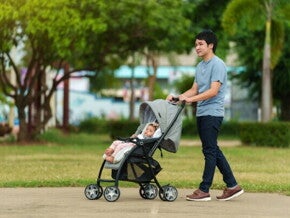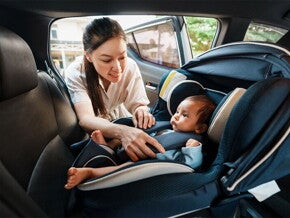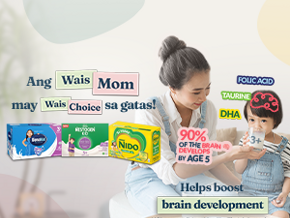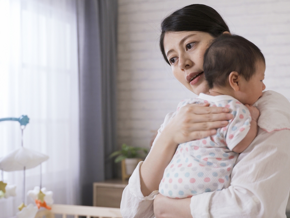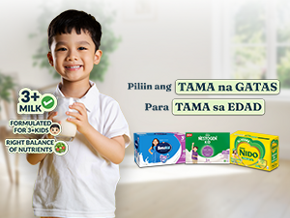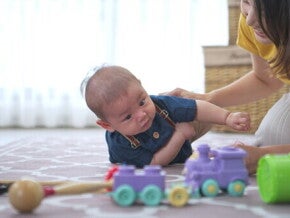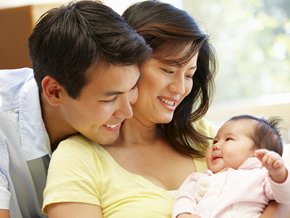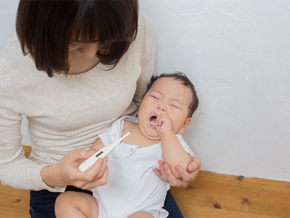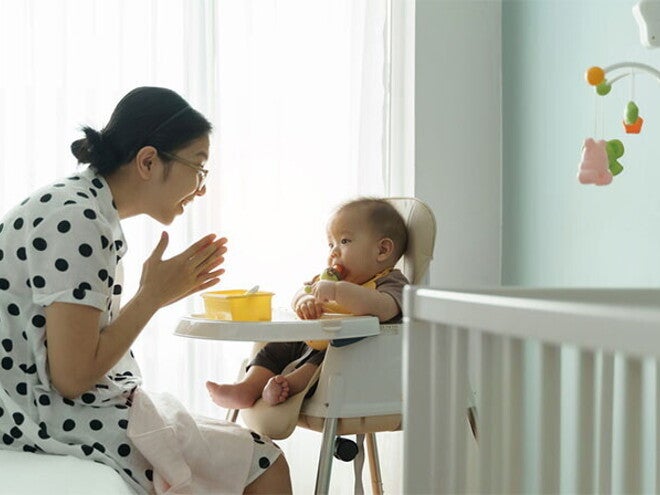
You’ve probably seen the reels and TikTok videos of babies squishing food in their hands or stuffing their fists into their mouths. You're excited to capture those moments, too. But starting solids often comes with one important piece of baby gear: the high chair.
This seat plays a big role in helping your child join family meals, build healthy routines, and eat safely. Here's what to know before you make space for one in your dining area.
Signs Your Baby Is Ready for a High Chair
Not every baby will be ready at the same age, and starting too soon can be uncomfortable or even unsafe. Rather than relying on the calendar, talk to your pediatrician about the signs of readiness for your child.
Here are some of the cues your pediatrician will look for:
- Your baby can sit upright without support. They won't slump or tip over when sitting down.
- They can hold their head steady for the entire meal, not just in short bursts.
- They show interest in joining your mealtime like opening their mouth when they see food. They may also reach out or light up when they see others eating.
If your pediatrician gives you the green light that your baby is ready for a high chair, it's time to know what kind of high chair is worth buying.
Safety Features to Look for in a High Chair
High chairs may appear similar, but those that are worth the investment follow safety standards set by countries like Singapore, the United States, Canada, or Australia.
While the details may vary slightly, the goal is the same across these standards: prevent falls, reduce injury risks, and ensure child-safe materials. Here’s what to look for:
Secure, adjustable straps
Pick a restraint system with either a three- or five-point harness to prevent your baby from slipping out or climbing over the tray.
The Australian Competition and Consumer Commission's (ACCC) safety standards recommends a five-point harness, which goes over the baby's shoulders, around their waist, and between their legs, is the safest. But a three-point harness is effective if the waist and crotch straps are firmly fastened.
Stable base
The legs should have a wide base and be sturdy enough that the chair doesn't wobble or tip over when your baby leans to one side, kicks their feet, or climbs out of the chair.
Singapore's Consumer Product Safety Office (CPSO) recommends applying weight to both the seat and backrest of a baby high chair to check for any squeaking, sagging, or movement out of position.
In the United States, regulations for high chairs require manufacturers to conduct stability tests in forward, backward, and sideways directions. The goal: the chair does not tip over when occupied by a child up to 3 years of age.
Tray and seat durability
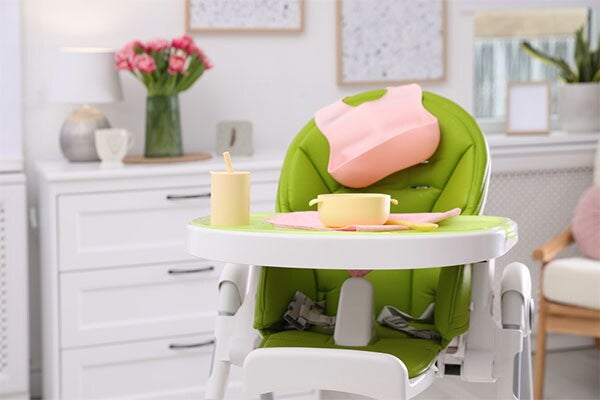
Don't use the tray to hold a child in a high chair. Always use restraints.
According to the U.S. Consumer Product Safety Commission (CPSC), high chairs must pass durability and mechanical strength tests, including those for seat and tray locking mechanisms, to prove there won't be breakage after repeated use. There should also be no easily detachable parts that could pose a choking hazard.
No pinch points or sharp edges
Pay close attention to the folding parts, like the joints and trays, that could trap your baby’s fingers or toes. If a tray is removable, Singapore's CPSO suggests pulling it from different sides to ensure it's not coming loose or out of place.
Check for sharp points along the edges of the chair and around the tray that could cut a child. The Canadian government requires manufacturers to provide a smooth finish over exposed wooden or plastic parts, so they're free from splits, cracks, and other defects that could cut your baby's skin.
Adjustable features
The ideal high chair should grow with your child up to 3 years old. So it should have an adjustable height with a seating surface more than 15 inches above the floor.
The high chair should also have a footrest for proper posture and comfort. It provides your baby with a place to rest their feet, which can help with stability and focus during mealtimes.
Latching or locking mechanism
When looking for foldable high chairs, check for sturdy latching or locking devices. They should be tough enough that they won't disengage easily with a little push. If the chair has wheels, make sure they can lock completely in place to avoid rolling accidents.
Visible safety warnings
High chairs that have passed safety standards have clear and permanent labeling of safety warnings. User instructions can also come in multiple languages.
Safety certification
Some baby high chairs that meet the minimum safety requirements may carry the following safety seals or labels:
- Singapore: "Safety Mark" with a unique 8-digit registration number
- United States: Baby Safety Alliance, formerly the Juvenile Products Manufacturers Association (JPMA)
- European Union: "CE" marking
- Australia: StandardsMark
Are Used or Hand-Me-Down Baby High Chairs Safe?
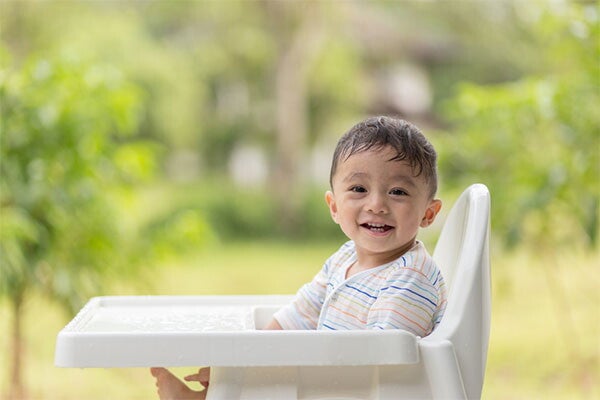
Spills and smears are a given, so go for high chairs with fewer seams and crevices.
If you're going by the U.S. safety standards, a secondhand high chair is typically safe if it was made on or after June 19, 2019. Anything older may not comply with current safety features, such as improved stability and harness systems.
ACCC offers these guidelines when using or buying secondhand:
- If the chair doesn’t come with a proper harness, purchase one separately and make sure it's securely attached before use.
- Check if you can still download the assembly and usage instructions from the manufacturer’s website if the instructions are not included with the product.
- All parts, especially the locking mechanisms, straps, and tray, should be in good working condition with no broken or missing pieces.
You should also check if the high chair hasn't been recalled. Do a quick online search on the following product recall pages:
• Singapore: consumerproductsafety.gov.sg/consumers/safety-alerts-and-recalls/children-products/
• Australia: productsafety.gov.au/recalls
• United States: cpsc.gov/Recalls
• Canada: recalls-rappels.canada.ca/en
Where to Place a High Chair
Even the safest high chair can turn risky if it’s placed in a dangerous spot. These tips, based on Health Canada's safety advice, can help you avoid preventable injuries during mealtimes.
- Never place a high chair near stoves, ovens, or hot appliances to prevent curious hands from touching a hot surface.
- Avoid placing the chair near windows or screens that babies can push against to avoid accidental falls.
- Keep cords from appliances, curtains, and blinds far from your child’s reach.
- Avoid positioning the high chair near walls or counters. Babies can push their feet against these surfaces, which may cause the chair to tip backward or sideways, even with a stable base.
- Foldable high chairs should be stored out of reach of children when not in use. Young children may try to climb on it or pull it down.
The rule of thumb? Give the high chair enough space on all sides and remove access to anything your child can pull, push, or climb on.
A High Chair's Role in Building Good Eating Habits for Kids
A high chair is bulky, and it's more convenient than having your baby sit on your lap. But high chairs do more than hold your child while they eat. Here's how it can shape your child’s approach to food and mealtimes.
Creates boundaries
A high chair teaches babies that meals occur at the table, not during playtime or while they're crawling. Over time, you won't have to remind them how to behave during mealtimes.
Supports independent eating
Sitting upright makes it easier for your baby to focus on eating. The posture allows them to grab, chew, or swallow without tipping over or needing full-body support, reducing the likelihood of choking.
Promotes social learning
Make an effort to eat together as a family whenever possible. Children learn by watching, and seeing you enjoy healthy foods can encourage them to do the same.
Being eye-level with parents and siblings gives babies the chance to watch and mimic how others eat, which is part of how they learn.
Yes, having your baby there makes family meals feel chaotic, but you know that's only temporary. Even if your baby eats just a few spoonfuls or plays with a spoon more than the food, sitting in the high chair serves as a starting point for establishing positive eating habits. And that can benefit your child for years to come.
Share your high chair moments at the ParenTeam Moms and Dads Facebook group.
References
Health Canada. “High Chairs.” Canada.ca, January 11, 2021. Accessed July 25, 2025. https://www.canada.ca/en/health-canada/services/infant-care/high-chairs.html
NHS GGC. “High Chair Information Sheet,” June 7, 2023. Accessed July 25, 2025. https://www.nhsggc.org.uk/kids/resources/ot-activityinformation-sheets/high-chair-information-sheet/
U.S. Consumer Product Safety Commission. “High Chairs.” Accessed July 25, 2025. https://www.cpsc.gov/FAQ/High-Chairs
U.S. Consumer Product Safety Commission. “New Federal Standard to Improve Safety of High Chairs Takes Effect.” Accessed July 25, 2025. https://www.cpsc.gov/Newsroom/News-Releases/2019/New-Federal-Standard-to-Improve-Safety-of-High-Chairs-Takes-Effect
“Regulations.gov.” Accessed July 25, 2025. https://www.regulations.gov/document/CPSC-2015-0031-0020
Safety, Accc Product. “High Chairs Guide.” ACCC Product Safety, January 28, 2025. Accessed July 25, 2025. https://www.productsafety.gov.au/consumers/keep-baby-safe/feed-and-soothe-baby-safely/high-chairs-guide
“Safety Tips on Highchairs.” Accessed July 25, 2025. https://www.consumerproductsafety.gov.sg/safety-tips-on-highchairs/
HealthyChildren.org. “Starting Solid Foods.” Accessed July 25, 2025. https://www.healthychildren.org/English/ages-stages/baby/feeding-nutrition/Pages/Starting-Solid-Foods.aspx










